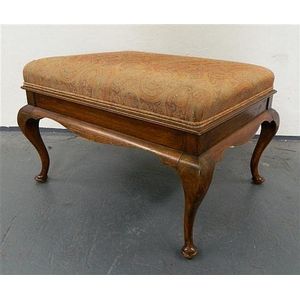Mahogany Bench with Carved Cabriole Legs and Claw Feet
You must be a subscriber, and be logged in to view price and dealer details.
Subscribe Now to view actual auction price for this item
When you subscribe, you have the option of setting the currency in which to display prices to $Au, $US, $NZ or Stg.
- Claw Feet - Carved or cast in the shape of a lion's claw or the talons of other more fabulous beasts. They may be found on chair and table legs, supporting platform bases, and cabinets in the Classical Revival manner. Claw feet are not uncommon on Australian furniture made throughout the 1850s and 1860s, though, as with all forms of carving, the deeper and richer the claws are carved, the earlier the piece is likely to be.
- Cabriole Leg - The cabriole leg evolved from an elongated scroll, curving out at the knee which may or may not be carved, and forming a serpentine shape as it descends to the foot.
First introduced into English furniture in the late 17th century, cabriole legs were widely used during the Queen Anne and early Georgian periods, where they frequently terminated in a pad foot or ball and claw foot. The style has had many imitators since then. The cabriole leg was re-introduced in the mid-19th century, and is commonly associated with the balloon-back dining or drawing-room chairs made in walnut, mahogany or, in Australia, cedar. The Victorian cabriole leg, on the whole, was rather more slender than the earlier form, following the French style, which emphasized the delicacy and daintiness of the chairs they were designed to support. Cabriole legs are sometimes found on windsor chairs, especially those made during the 18th century. - Provenance - A term used to describe the provable history of an antique or work of art, and thus an additional aid to verifying its authenticity. Provenance can have an inflating effect on the price of an item, particularly if the provenance relates to the early settlement of Australia, a famous person, or royalty. Less significant are previous sales of the item through an auction house or dealer.
- Mahogany - Mahogany is a dense, close grained red-coloured timber from the West Indies and Central America. It was first imported into Europe in the the early 18th century and its use continued through the 19th century. It was popular for furniture making because of its strength, the wide boards available, the distinctive grain on some boards, termed flame mahogany and the rich warm colour of the timber when it was polished.. The "flame" was produced where a limb grew out from the trunk of the tree, and this timber was usually sliced into veneers for feature panels on doors, backs and cornices.
Some terms used to describe mahogany relate to the country from which it originally came, such as "Cuban" mahogany, "Honduras" mahogany etc. However unless the wood has been tested the names assigned are more a selling feature, rather than a true indication of the timber's origin.
This item has been included into following indexes:
Visually similar items

A Chippendale style carved walnut footstool, English, circa 1765, 49 cm high, 69 cm wide, 50 cm deep. Provenance: Property of a Gentleman, Melbourne

A French walnut framed ottoman, circa 1870. 39 cm high, 80 cm wide, 80 cm deep

A fine Georgian ottoman, with shaped apron and cabriole legs with pad foot upholstered in 19th century paisley fabric. Provenance: St David's Cathedral, Hobart

A Louis XV style walnut duet stool, French 19th century
